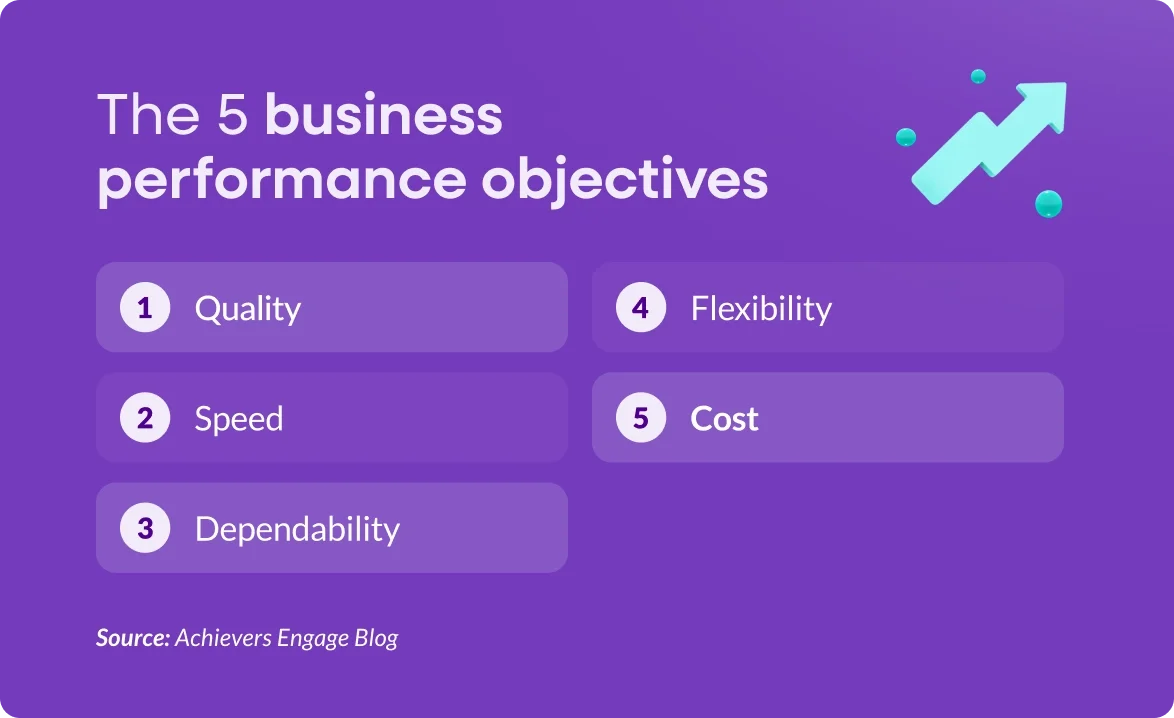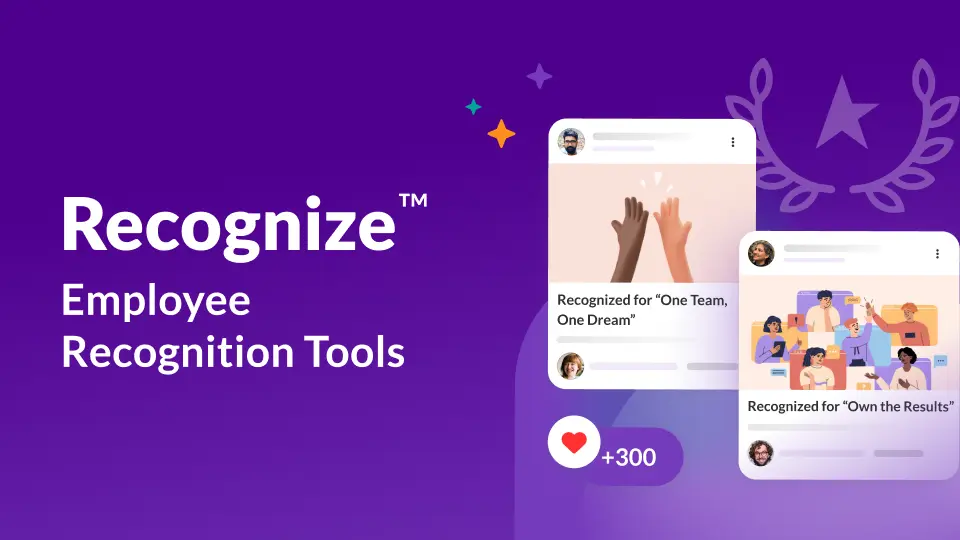Table of contents
To improve business performance, every decision your organization makes should drive results. But with so many options and limited resources, it’s tough to know where to focus your time and attention. Not all initiatives will have the same impact, so it’s important to prioritize the ones that will truly move the needle — like employee recognition.
According to Achievers’ 2024 State of Recognition Report, recognition is a key driver of business results. Our research found that 60% of businesses with an online recognition platform were seeing measurable results, compared to only 30% of those with an in-house program.
To truly improve business performance, you need to focus on strategies that align with your company’s goals and have a track record of success. Only then can you make the most of your strategies.
So, if you’re ready to take your organization to the next level, we’ve got you covered with the best ways to improve business performance and start seeing real results.
What is performance improvement in business?
Performance improvement in business is about finding ways to make an organization more efficient and effective. It means identifying areas where changes could be made to save money and time, or where things could be streamlined on a more holistic level. Performance improvement can involve products or services, but it can also focus on areas like workforce productivity or customer satisfaction.

What are the 5 business performance objectives?
When it comes to improving business performance, it’s important to focus on key objectives. These objectives help organizations streamline operations and set clear, measurable goals. By understanding the five key performance goals, you can focus on the initiatives that drive long-term growth and success.
- Quality: Quality products or services build trust, reduce errors, and strengthen customer loyalty, ultimately elevating your brand reputation and driving repeat business.
- Speed: Faster turnaround times improve customer satisfaction, give you a competitive edge, and help maintain strong, positive relationships with your audience.
- Dependability: Reliable businesses ensure long-term success through repeat business and strong relationships with customers and stakeholders.
- Flexibility: Businesses that stay agile can stay competitive, seize new opportunities, and effectively navigate challenges.
- Cost: Balancing quality and efficiency helps businesses stay competitive, improve profitability, and reinvest in growth initiatives.
The 6 best ways to improve business performance
To drive real improvements in business performance, you need to focus on strategies that align with your goals and workforce. From defining clear objectives to ensuring employee engagement, these six actionable steps can help position your organization for sustained growth and success. Let’s dive in:
1. Define your business goals
Improving business performance starts with defining clear, actionable goals, objectives, and key results (OKRs) and aligning them with your company’s strategy. When businesses move forward without fully defining these goals, it can get in the way of success.
To define your business goals:
- Involve key stakeholders: Gather input through feedback tools from staff at all levels — front-line staff to executives — to ensure everyone is on the same page.
- Use data-driven insights: Analyze internal performance, market research, and external feedback using an engagement platform to find strengths and areas for improvement.
- Align goals across teams: Ensure everyone shares the same vision and is committed to collective success.
2. Recruit and develop talent with the right skills and cultural fit
At the end of the day, business performance relies on your team’s skills and motivation. If employees don’t believe in your company’s mission, fit with the culture, or have the right abilities, performance will suffer.
Create a strong employee value proposition (EVP) that attracts top talent and prioritize hiring people who align with your culture. Research from Achievers 2024 Engagement and Retention Report found culture alignment to be one of the five best ways to increase an employee’s emotional salary. Once you have cultural alignment, it’s important to support and develop that talent with the right resources to boost performance and show your team that you’re invested in their success.
3. Keep your finger on the pulse of key metrics
Data reporting and analytics are the backbone of organizational success. After all, you can’t improve what you don’t measure. While tracking revenue and profit is important, it’s just as essential to understand what drives employee performance. This could include factors like engagement, recognition, wellness, or professional development.
Use tools like engagement surveys and other employee feedback software to get anonymous, secure input from your team and learn what’s working and areas that need improvement.
4. Increase employee engagement
Employee engagement is how motivated and excited team members are about their jobs daily. Highly engaged employees come up with innovative ideas for making your company better, give their all to every task, and serve as your organization’s best advocates when it comes to building a great employer brand.
Unfortunately, disengaged employees can have the opposite effect, only doing enough to get by, rarely sharing their thoughts on important issues, and spreading disengagement to others.
Here’s how you can start to improve engagement:
- Identify key drivers of employee engagement, such as frequent recognition and a strong, supportive culture.
- Use an employee engagement solution to measure these drivers and address issues quickly.
- Train managers to create collaborative action plans with their teams, ensuring everyone is invested in the solutions and outcomes.
5. Show team members they’re valued with employee recognition
A great salary, top-tier benefits, a well-designed office — all these can fade into the background if you feel unappreciated at work. Employee recognition feeds into engagement, letting team members know they and their contributions are valued by peers, leaders, and the company as a whole.
Look for a rewards and recognition program that goes beyond one-off gestures to create a culture of appreciation across the organization. It should balance monetary and social recognition, making it easy for employees to celebrate achievements at all levels. The best programs use modern tools to deliver seamless, global recognition experiences while aligning with your company’s values and goals.
6. Identify and understand your target market
Your company’s target market is made up of customers who are a great fit for your products or services. By defining this market, you can focus your marketing and sales efforts where they’ll really count, instead of wasting time and resources trying to appeal to everyone.
To better understand your target market:
- Gather insights: Use employee surveys, customer data, and feedback tools to uncover their needs, preferences, and challenges.
- Ask the right questions: What problems are they trying to solve? What features or services matter most to them?
- Refine your offerings: Use this information to tailor your products or services, ensuring they align with customer expectations.
The business results of improved performance
When your team’s performance improves, the entire business benefits. From boosting revenue to keeping employees happy and productive, there are clear advantages to focusing on performance across your organization.
Here’s how better performance can drive results in key areas:
Revenue growth
When your employees are engaged and giving their best, it directly impacts your bottom line. A motivated, productive team drives more sales, keeps customers coming back, and helps you take advantage of new opportunities. Streamlined operations, better decision-making, and fresh ideas all equal higher revenue.
In short, when you focus on performance, you’re fueling growth and profitability. It’s a win-win for both your team and the business.
Employee retention
Improving performance means building an environment where employees feel connected to the company’s goals and culture. This leads to higher job satisfaction and stronger employee retention.
Plus, when employees see opportunities for growth, they’re more engaged in their roles, which helps strengthen retention. Reduced turnover means less time and money spent on recruitment and training, and a more stable workforce to drive long-term success.
Increased productivity
Performance improvement leads to a more efficient, productive workforce. When employees are clear on their goals and feel motivated, they can accomplish more in less time. Performance-driven teams are often better at prioritizing tasks, solving problems quickly, and finding new ways to streamline operations.
This not only helps them meet targets but also increases the overall output of the business. In a nutshell, improving performance means getting more done with less effort, and that’s always a win for business.
Customer satisfaction
Happy employees lead to happy customers. When your team is engaged and performing well, they’re more likely to deliver exceptional service and create memorable experiences for customers. Engaged employees take pride in their work, going the extra mile to ensure customer satisfaction. This results in repeat business, positive reviews, and loyal customers who trust your brand.
By creating a high performing organizational culture, you’re also creating a culture of exceptional customer service that keeps people coming back.
Optimized costs
Improved performance isn’t just about getting more out of your team — it’s also about reducing waste and optimizing resources. When employees are aligned with business goals and working efficiently, they find ways to cut costs and improve processes.
Whether it’s better use of time, reduced errors, or improved resource management, performance-driven teams naturally help minimize unnecessary expenses. This allows businesses to reinvest savings into growth initiatives, making the company more competitive in the long run.
Improve business performance by engaging your employees today
When employees are motivated and engaged, business performance benefits. But to see the kind of success you’re looking for, you need to know what factors engage employees and how to start positively impacting them. However, if managers don’t have access to the tools they need to analyze engagement and motivation, it can put up a roadblock that impacts business performance.
Achievers is ready to help you build the platform you need to track and act on the drivers of employee engagement, starting with Achievers Recognize. Our science-backed employee recognition platform makes it easy to reward positive behaviors and help improve business performance across your organization.



